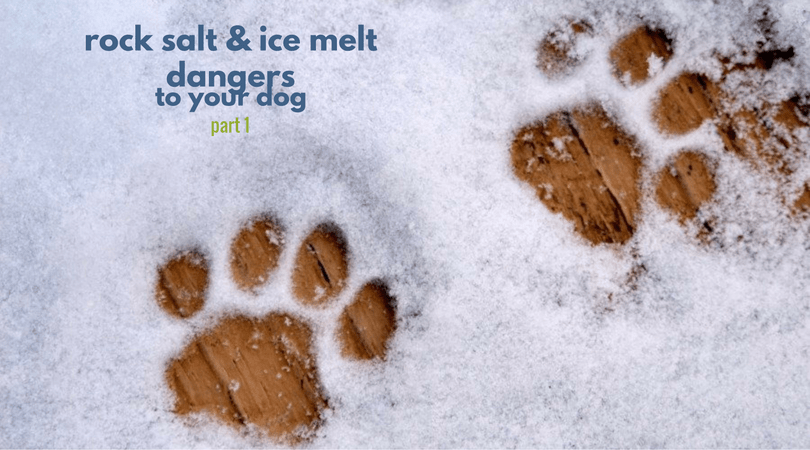Rock Salt and Ice Melt Dangers To Your Dog, Part 1
Winter is just around the corner and with winter comes snow and ice! If you've used rock salt to keep from slipping and sliding on the ice, you should be aware of its harmful effects on your four-legged family members.
Every winter veterinarians receive an influx of calls and visits from pet parents with dogs who have been exposed to rock salt and ice melt products.
Dogs are extremely vulnerable to ice melt and rock salt as it is spread over driveways, roads, parking lots, walkways and stairs - the same areas where dogs walk.
Do Pet Safe Ice Melts Work?
There are many different types of ice melt and while the ingredients vary, most use some of the following: calcium salts (calcium carbonate, calcium magnesium acetate, and calcium chloride), sodium chloride, potassium chloride, magnesium chloride and urea.
Many of the "pet safe" ice melts contain urea (carbonyl diamide), an ingredient found primarily in fertilizers as it is 46% nitrogen.
Urea is synthesized from natural gas (not urine as you may think from the name) - although we have found that yellow in the snow is quite effective at snow melt!
As an ice melt, urea is not very effective - working at temperatures at or above 25°. It provides some traction but does little to melt ice. If you spread it near shrubs, grass, and plants it will provide a nitrogen source but, use too much and come spring you'll notice the over-nitrogen burnt them up!
Are Pet Safe Ice Melts Really Safe?
Unfortunately, like pet grooming products, "pet safe ice melt" is yet another area that is not regulated for marketing claims. It is more accurate to say it is "saf-er" than some other ice melt options - not that it is a truly "safe" product.
Material Safety Data Sheets (MSDS) - that identify the ingredients don't take into consideration the structure of your dog's paw or the fact that dogs will investigate things by licking or consuming it.
Keep in mind that these granules can get lodged in your dog's paws - between paw pads where they can be an irritant - causing itching and inflammation. So while humans likely wouldn't have prolonged contact - your dog may! What does a dog do when their paw is inflamed - lick!
While not a carcinogen, ingestion can cause an upset tummy. If your dog will eat "anything" this is a real concern as consuming a lot will cause an electrolyte imbalance in their bloodstream causing possible dehydration, kidney issues, heart arrhythmia, and seizures.

Are Traditional Ice Melts Safe?
Traditional rock salt made from sodium chloride works to lower the melting temperature of ice. If the outdoor temperature gets below 20°, it is no longer effective.
Salt residue left over from these products can cause permanent damage to pavers, asphalt, concrete, wood decks, floors, and rugs. The salt also leeches into groundwater supplies and washes into lakes and streams harming aquatic wildlife. Salt-based ice melters also erode soil, kill plants, burn grass, and is toxic to birds.
The more popular ice melts use calcium chloride with other ingredients. They are more popular because they do actually melt the ice - working at temperatures as low as -50°.
They are designed to generate heat to melt the ice through chemical reactions. How much heat? A lot! Walk your dog through temperatures at 60°C (140°F) and their paws can suffer from chemical burns.
How Is Ice Melt Painful To Your Dog’s Paw Pads?
Depending on the condition of your dog’s feet and paw pads, having to trek across rock salt can be anywhere from uncomfortable to excruciating. The tiny granules of rock salt can get stuck in your dog’s paws and cause pain with every step. Have you ever put on a shoe with a pebble in it? Within the first few steps you begin to notice an unpleasant poking into your foot. It doesn’t take long before you remove your shoe to fish the pesky stone from your footwear. Now imagine being a dog and not being able to remove the stone from your shoe — Ouch!
If you notice your dog’s paw pads are red, swollen or irritated, or your pup starts limping and even refuses to walk outside during winter, they may be experiencing the negative physical effects of rock salt. One of the worst things you can do if you notice your dog in discomfort is continue to let them walk on the melting product. If your dog’s paw pads are already cracked and broken, the pain will be intensified by walking on more salt and literally rubbing salt in the wounds.

Paw Pad Moisturizer
If you’re looking for an all natural solution for your dog’s burned or cracked paw pads, 4-Legger has the perfect solution for you. We’ve created a certified organic Healing Balm to help sooth and heal rough, irritated, chapped and cracked paw pads. Some of the organic ingredients in our balm include organic hemp oil, calendula extract and natural vitamin E to help restore your dog’s paws with antioxidant and anti-inflammatory properties.
In part two of this series, we’ll discuss why rock salt is harmful to your dog’s stomach as well as tips you can take to avoid this winter hazard. If you’re interested in learning more about 4-Legger’s organic pet products, browse our online store or contact us today!




